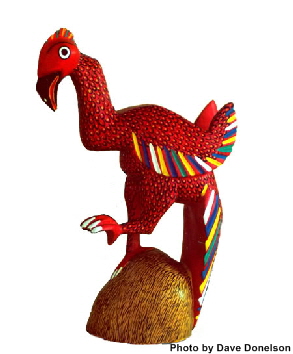|
Disney’s FamilyFun
May, 2004
Celebrate Cinco de Mayo by crafting these whimsical Mexican stick sculptures
By Dave Donelson
Flying giraffes, polka-dotted crocodiles, and dancing purple roosters inhabit the Mexican state of Oaxaca. They are made by families who sell them by the thousands to delighted tourists, gift shops, and folk art galleries around the world.
 These creatures are animalitos (also called alebrijes)—hand-carved brightly-painted wooden figures representing native animals like armadillos, coyotes, and lizards as well as barnyard animals and birds. A host of imaginary creatures—dragons, mermaids, and aliens from outer space—are carved as well. Many carvers also produce both real and fanciful human figures. These creatures are animalitos (also called alebrijes)—hand-carved brightly-painted wooden figures representing native animals like armadillos, coyotes, and lizards as well as barnyard animals and birds. A host of imaginary creatures—dragons, mermaids, and aliens from outer space—are carved as well. Many carvers also produce both real and fanciful human figures.
Styles can be primitive and rough or smooth, round, and flowing. The carving and painting are done in the family “workshop,” which is often a shady tree in the backyard.
Zapotec and Mixtec Indians have been carving in the Oaxaca region for at least 2500 years. Their intricate bas relief work can be seen in the ruins of Monte Alban, the ancient city on a mountaintop overlooking the valley. Their descendants today live in villages specializing in crafts like weaving, pottery, and metalwork as well as woodcarving.
The best-known carvers work in Arrazola, San Martin Tilcajete, and La Union Trejalapan, small villages a few dusty miles from the city of Oaxaca. In the last thirty years, almost 100 of the approximately 500 families in Arrazola alone have turned from subsistence farming to take up the craft of making animalitos.
Just as on a family farm, everyone has a role in the business. Traditionally, the men carve while the women and older children sand and paint. The younger children recruit customers from among the tourists and collectors drawn to the villages by the remarkable array of unique figures, masks, and furniture.
Your family can make animalitos, too, with a minimum of tools. All you need is an interesting tree branch (ramble in the woods, anyone?), a few simple tools, and some paint. The larger the branch, the easier it is to paint, but there are no hard-and-fast rules: some animalitos are two inches long, others six feet tall! The more contorted the wood, the more interesting the animal it can make, so keep an eye out for fallen limbs with lots of branches close together or from gnarly trees like blackjack oak. Don’t cut a branch from a living tree, though, because the wood will be too wet and the bark will be too tight. Besides, it could injure the tree!
Here’s what you need to make a simple animalito:
- Tree branch
- Pruning shears or saw
- Medium-grit sandpaper
- Paints & applicators
- These are the easy steps to follow:
1. Shape the branch by removing unwanted twigs with the pruning shears or saw (adults only, please). Try to leave three or more protruding twigs as “legs” for your animal to stand on. Even an interesting twisted branch without “legs,” though, can become a fanciful snake or eel!
2. Peel and sand off all loose bark and dirt. It doesn’t have to be completely smooth—just make sure the paint will have something firm to adhere to.
3. Paint away! Start with a solid base coat or primer, then use as many colors and designs as you can imagine. Speed up drying time between coats with a hand-held hair dryer. And don’t just use brushes: sponges are good for putting paint on large areas and toothpicks, matchsticks, or even twigs make great polka dots and stripes.
Carvers in Oaxaca sometimes add features using found materials like goat (or human) hair, cactus spines, splinters of wood, and fibers from maguey leaves. Your animalito can be adorned with sequins, ribbons, feathers, construction-paper wings, or just about anything else you want to add with a dot of glue.
Making fun figures like these doesn’t require a great deal of technical woodworking knowledge. More important are the qualities of the Oaxacan animalito carver: patience and imagination.
--End--
|